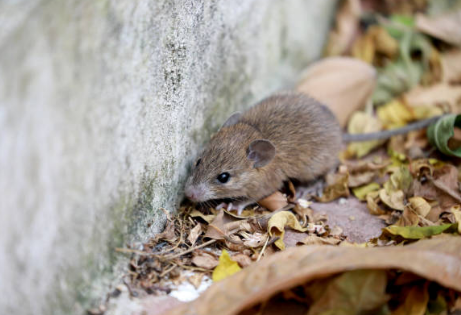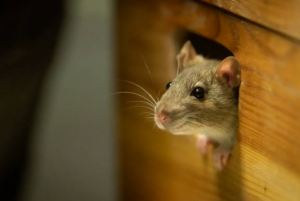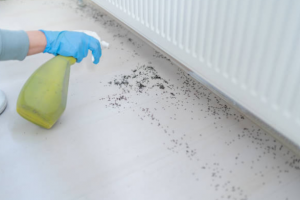As the temperatures drop in the fall and winter seasons, people look to escape the cold by turning on their heat, winterizing their homes, and spending more time indoors. However, you are not the only one looking for warm shelter in the winter, mice are also looking for somewhere warm to endure the winter and they may end up seeking the warmth of your home.
It is common to have mice in your home during the winter as these animals do not hibernate and instead seek warm and secure shelter when the weather gets cold. Houses and other buildings offer warm, secure attic and wall spaces as well as access to food and water, which attracts mice seeking a winter home. Even structures that aren’t temperature controlled, like garages and sheds, offer protection from the elements. Once mice get into your home, they can cause significant damage to your property and even put your health at risk. They may also breed in your home which can quickly cause a large infestation.
In this guide, we will discuss how mice get into your home and what you can do to prevent this, the signs of a mouse infestation, and the damage and health risks they bring. If your home has been soiled or damaged by intrusive mice, our professionals at ServiceMaster S&R Systems can help clean up rodent waste and restore your home to safe conditions.
How Mice Can Enter Your Home
Mice are crafty, resourceful animals that can find many different ways to get into your home. They have several surprising physical attributes that help them invade homes and buildings as they can run up rough vertical surfaces and jump 13 inches from the ground to a flat surface. They are also excellent swimmers. Most of the time, they get into homes by gnawing and chewing through wood, aluminum, plastic, and other materials and they can squeeze through spaces the size of a dime because they have no collar bones.
The following are some of the most common entry points mice use to get into your home:
- Foundation cracks: Mice can squeeze through foundation cracks as small as 3/16 of an inch.
- Utility line openings: Mice can fit through gaps around utility lines including water pipes, gas lines, and electrical wiring.
- Attic and roof vents: Roof vents, chimneys, and other small openings on the roof can allow mice into the home.
How to Prevent Mouse Infestations
Understanding how mice can get into your home can help you take the right steps to keep them out of your home. You can prevent mouse infestations by taking the following steps:
- Seal entry points: As discussed above, mice can fit into very small cracks and gaps very easily. Thoroughly check your home, including the foundation, windows, doors, roof, attic, and utility line entry points for cracks, holes, and gaps, and seal them using caulk or steel wool. Any hole or opening that is 3/16 of an inch or bigger should be sealed.
- Store your food: In the winter, mice are seeking food as well as shelter. Make sure all of your food, including pet food, is stored properly in sealed glass, plastic, or metal containers. You should also clean up crumbs and spills to avoid attracting mice.
- Reduce clutter: Clutter in the attic, basement, or garage attracts mice because they have many places to hide. Clearing the clutter from these areas makes them less appealing to mice.
- Fix water leaks: Mice are attracted to indoor water sources in the winter because there is less water available outdoors. This makes it important to repair leaking pipes or faucets as well as foundation and roof leaks.
Signs of Mice in Your Home
The tricky thing about mouse infestations is that mice can go unseen for weeks or even months after entering a home. This is largely because they are nocturnal and there are many places in your home for them to hide. Knowing the signs of a mouse infestation can help you tell if you have mice in your home, even if you never see one.
The following are the most common signs that you have mice in your home:
- Scratching, squeaking, or scurrying noises within the walls and above ceilings.
- Droppings and urine stains near baseboards, within cabinets, underneath sinks, and around food sources. Their droppings are small and dark brown in color.
- The presence of a musky odor.
- Footprints and tail marks that may be visible on dusty surfaces.
- Smudges from the oil and dirt in mouse fur on walls, pipes, and beams.
- Visible signs of gnawing on doors, drywall, and other materials.
- Nests made of shredded materials including paper, fabric, or insulation. These nests look like balls of loosely woven material and are usually found in attics, basements, garages, and closets.
Damage Caused by Mice
Mice can cause significant property damage by chewing on various materials and contaminating food and areas of your home with their droppings and urine. The following are the ways that mice can cause damage in your home:
- Mice will nibble on all food they encounter within your home and contaminate your food by leaving their urine, droppings, and hair behind.
- Mice chew on insulation which reduces energy efficiency for heating and cooling.
- They can cause structural damage by chewing on drywall and wood support beams.
- Mice commonly chew on electrical wiring which damages the electrical system and increases the risk of a fire. They may also get into electrical appliances and damage the wiring and insulation inside these appliances.
- Mice can damage your personal belongings including books, artwork, clothing, important documents, and other items by chewing on them.
Health Risks Caused by Mice
Property damage is not the only danger mice pose to your home. They can also threaten your health by spreading infection and diseases to people and pets directly and indirectly through parasites like flea and ticks. The following are the health risks mice can bring into your home:
- Salmonellosis: Consuming food or water contaminated by rodent droppings or urine can cause food poisoning such as salmonellosis.
- Rickettsialpox: This condition causes flu-like symptoms and a rash over the entire body. It is transmitted to humans by mites from mice.
- Lymphocytic Choriomeningitis (LCMV): LCMV causes flu-like symptoms and can be contracted by coming into contact with mice, urine, and droppings as well as dust contaminated by their urine or droppings.
- Leptospirosis: This condition causes flu-like symptoms and is caused by consuming food or water contaminated by mice urine and droppings or coming into contact with urine from infected mice.
- Ringworm: Ringworm is a fungal skin infection that causes red patches all over the body. People may get ringworm from mice though direct contact or by touching something that was contaminated by a mouse.
What to Do If There are Mice in Your Home
If you determine that there are mice in your home, it is important to act quickly to remove them. Addressing the infestation right away can help limit the damage they cause and reduce the risk of potential health effects. You can take the following steps to remove mice from your home:
- Set traps: Put mouse traps in areas where you have seen mice or signs of their activity. You can consider humane traps if you prefer to release them.
- Call an exterminator: If the infestation is too much for you to handle by laying traps, call a professional exterminator. These professionals will effectively remove the mice from your home.
- Call a restoration professional: Once the mice are removed from your home, the affected areas may need to be repaired and disinfected. Restoration professionals like ServiceMaster S&R Systems can repair damage caused by gnawing mice and clean up mouse urine and droppings to restore safe conditions.
Rodent and Animal Waste Cleanup from ServiceMaster S&R Systems
This winter, make sure you take the necessary steps to protect your home from mice and stay vigilant for signs of a mouse infestation. If you do find mice, set out traps and call an exterminator to ensure that the infestation is eliminated. Once the mice are removed, it is important to have the affected areas repaired and disinfected so you can use your home again safely.
Our professionals at ServiceMaster S&R Systems provide rodent and animal waste cleanup services to remove dangerous materials and restore the damage caused by the intrusive mice. Our technicians can safely remove biohazard materials like urine, blood, and feces as well as clean and disinfect the affected areas to eliminate the risk of disease or infection. We can also repair structural damage caused gnawing and chewing.
If you have recently had a mouse or rodent infestation and need rodent cleanup services to restore safe conditions, call ServiceMaster S&R Systems at (630) 896-0030 for effective cleanup, disinfection, and repairs.



